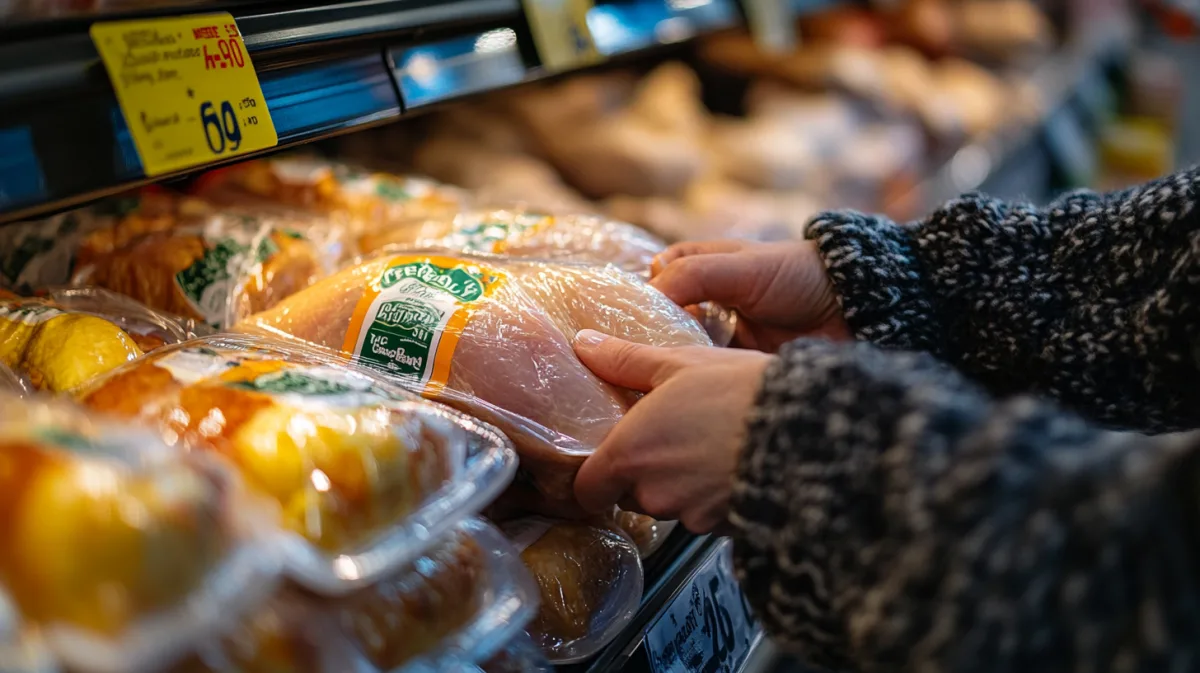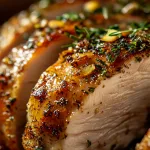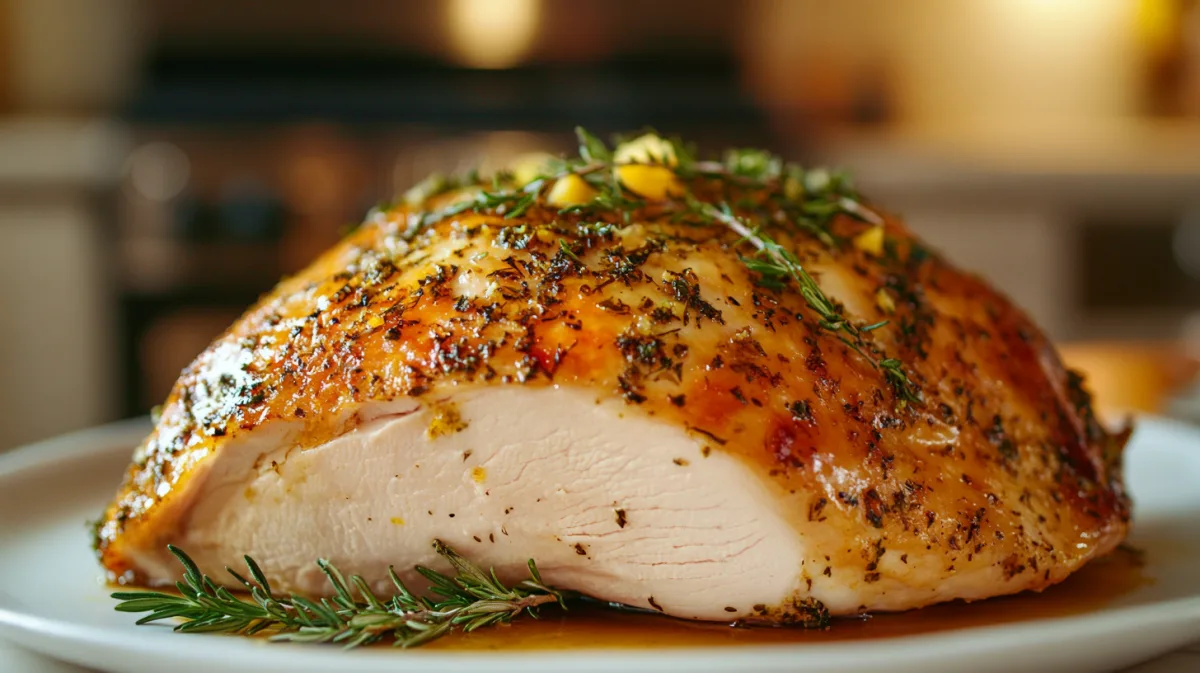Easy Butterball Turkey Breast Cooking Instructions with a Complete Temperature Table
Stumped by a Butterball turkey breast? You’re not alone. Many cooks find this holiday staple challenging. But don’t sweat it. We’ve got your Butterball turkey breast cooking instructions right here. These simple steps will take you from package to perfectly cooked, no stress required.
Ready to turn that bird into a masterpiece?
Preheat your oven and grab your apron. It’s time to demystify the process and make your next Butterball turkey breast the star of the show. Let’s get cooking!
Complete Butterball Turkey Breast Cooking Time Table for Perfect Results
To cook a Butterball turkey breast perfectly, preheat your oven to 325°F (165°C). Cook for about 20 minutes per pound, or until the internal temperature reaches 165°F (74°C) at the thickest part.
For example, a 3-5 lb breast will take about 1¾ – 2¼ hours.
Always use a meat thermometer for accuracy, and let the turkey rest for 15-20 minutes before carving.
| Turkey Breast Weight | Approx. Cooking Time (at 325°F) | Internal Temp (done) | Resting Time |
|---|---|---|---|
| 2 – 3 lbs | 1¼ – 1¾ hours | 165°F (74°C) | 15 minutes |
| 3 – 5 lbs | 1¾ – 2¼ hours | 165°F (74°C) | 15-20 minutes |
| 5 – 7 lbs | 2¼ – 2¾ hours | 165°F (74°C) | 20 minutes |
| 7 – 9 lbs | 2¾ – 3¼ hours | 165°F (74°C) | 20-25 minutes |
Additional Helpful Information:
- Oven Temperature: Preheat and cook at 325°F (165°C) for all sizes.
- Thawing Time: Allow 1 day of thawing in the refrigerator for every 4 lbs.
- Seasoning Tip: Season under the skin for maximum flavor penetration.
- Basting: Begin basting after the first hour, then every 30 minutes.
- Tent with Foil: Cover loosely with foil if browning too quickly.
- Stuffed Breasts: Add 15-30 minutes to the total cooking time if stuffed.
- Use a Meat Thermometer: Always check the internal temperature at the thickest part.
- Let it Rest: Resting allows juices to redistribute, ensuring moist meat.
- Carving: Wait until after resting to carve for juicier slices.
- Leftovers: Refrigerate within 2 hours and consume within 3-4 days.
Remember: These times are approximate. Factors like oven accuracy, starting meat temperature, and basting frequency can affect cooking time. Always rely on the internal temperature for doneness.
Choosing Your Butterball Turkey Breast

Before we dive into the cooking process, let’s talk about selecting the perfect Butterball turkey breast. Size matters when it comes to feeding your crowd and ensuring even cooking. For a typical family gathering, a 3 to 5-pound breast is ideal. This size range offers a good balance between cooking time and yield.
When you’re at the store, look for a breast that feels firm to the touch. Check the packaging for any signs of damage or excess liquid, which could indicate thawing and refreezing. Remember, fresh is best, but if you’re planning ahead, a frozen breast works just fine.
Consider whether you prefer bone-in or boneless. Bone-in breasts often provide more flavor, while boneless are easier to carve. Butterball offers both options, so choose based on your preference and comfort level.
Thawing Your Frozen Butterball Turkey Breast
If you’ve opted for a frozen Butterball turkey breast, proper thawing is crucial. The safest method is refrigerator thawing. Place your wrapped turkey breast on a tray in the refrigerator. Allow approximately 24 hours of thawing time for every 4 to 5 pounds. For a typical 3 to 5-pound breast, you’re looking at 1 to 2 days of thawing time.
In a pinch? You can use the cold water thawing method. Submerge the wrapped breast in cold water, changing the water every 30 minutes. This method takes about 30 minutes per pound. Never thaw your turkey breast at room temperature, as this can lead to bacterial growth.
Once thawed, cook your turkey breast within 1 to 2 days for optimal freshness and safety. Now that your bird is ready, let’s move on to the exciting part – preparation and cooking!
Preparing Your Butterball Turkey Breast

Preparation is key to a delicious Butterball turkey breast. Start by preheating your oven to 325°F (165°C). While the oven heats up, let’s get that turkey breast ready for its starring role.
First, remove the turkey breast from its packaging. Give it a good rinse under cold water, then pat it dry thoroughly with paper towels. This step ensures a crispy skin and helps the seasonings adhere better.
Now, it’s time to add some flavor. In a small bowl, mix 2 tablespoons of olive oil, 2 tablespoons of melted unsalted butter, and a blend of fresh herbs. Thyme, rosemary, and sage make a classic combination. Add 1 teaspoon of salt, 1/2 teaspoon of black pepper, 1/2 teaspoon of paprika, and 1/4 teaspoon of garlic powder for depth.
Here’s where we add our special touch – zest from one lemon and one orange. This citrus addition brightens the flavor profile and sets our recipe apart. Rub this mixture all over the turkey breast, making sure to get under the skin where possible.
Place your seasoned turkey breast, skin side up, on a roasting rack inside a shallow roasting pan. Don’t add water to the pan – we want roasting, not steaming. If you don’t have a rack, a bed of roughly chopped vegetables like carrots, celery, and onions works well to elevate the breast.
Roasting Your Butterball Turkey Breast
Now that your turkey breast is prepped and ready, it’s time for the main event – roasting. The key to a perfectly cooked Butterball turkey breast is maintaining the right temperature and knowing when it’s done.
Slide your roasting pan into the preheated 325°F (165°C) oven. As a general rule, allow about 20 minutes of cooking time per pound. For a 3-pound breast, you’re looking at approximately 1 hour of initial cooking time.
After the first hour, it’s time to start basting. Mix 1/2 cup of chicken broth with 2 tablespoons of melted butter, and the juice from the lemon and orange you zested earlier. This citrus-infused basting liquid will keep your turkey moist and add a subtle tangy flavor.
Baste the turkey breast every 30 minutes with this mixture. When the turkey is about 2/3 done (around 1 hour 40 minutes for a 3-pound breast), loosely tent it with aluminum foil. This prevents the skin from over-browning while the inside continues to cook.
Continue roasting until a meat thermometer inserted into the thickest part of the breast registers 170°F (77°C). This should take about 2 to 2.5 hours total for a 3-pound breast. Remember, cooking times can vary, so always rely on your thermometer rather than the clock.
Resting and Carving Your Butterball Turkey Breast

Once your Butterball turkey breast reaches that perfect 170°F (77°C) internal temperature, it’s time to let it rest. This crucial step allows the juices to redistribute throughout the meat, ensuring each slice is moist and flavorful.
Remove the turkey breast from the oven and let it sit, still tented with foil, for 15-20 minutes. This resting period not only improves the texture but also makes carving easier.
When it’s time to carve, use a sharp knife to slice against the grain. If you have a bone-in breast, start by cutting along one side of the breastbone, then angle your knife to slice away from the ribs. For boneless breasts, simply slice across the grain into even pieces.
Arrange your beautifully carved turkey on a platter, garnish with fresh herbs or citrus slices if desired, and get ready to impress your guests!
Nutritional Insights and Health Benefits
Let’s talk nutrition. A 3-ounce serving of roasted Butterball turkey breast (about the size of a deck of cards) contains approximately:
- Calories: 160
- Protein: 26 grams
- Fat: 6 grams
- Saturated Fat: 2 grams
- Cholesterol: 60 milligrams
- Sodium: 65 milligrams
- Carbohydrates: 0 grams
Turkey breast is an excellent source of lean protein, which is essential for muscle building and repair. It’s also low in saturated fat, making it a heart-healthy choice. Turkey is rich in B vitamins, particularly niacin, which aids in energy production and brain function.
Moreover, turkey contains selenium, an antioxidant that supports thyroid and immune function. The zinc in turkey promotes wound healing and helps maintain a healthy immune system.
By using our citrus-herb rub and basting method, we’re adding flavor without significantly increasing the calorie or fat content. The citrus adds a boost of vitamin C, while the herbs provide additional antioxidants.
Ingredient Alternatives and Variations
While our recipe for herb-crusted Butterball turkey breast with citrus butter baste is delicious as is, you might want to switch things up or accommodate dietary restrictions. Here are some alternatives to consider:
- Herbs: If you can’t find fresh herbs, dried ones work too. Use about 1/3 of the amount called for in the recipe when substituting dried for fresh.
- Citrus: No lemons or oranges? Try lime or grapefruit for a different twist. You could also use a tablespoon of apple cider vinegar for tartness.
- Butter: For a dairy-free option, replace butter with olive oil or a plant-based butter alternative.
- Chicken Broth: Vegetable broth or water can be used instead. For extra flavor, try white wine (if not serving to children).
- Seasonings: Experiment with different spice blends. Cajun seasoning, Italian herbs, or a barbecue rub can create exciting flavor profiles.
- Stuffing: While we focused on a simple roast, you could stuff the turkey breast with a mixture of breadcrumbs, herbs, and diced apples for added flavor and texture.
Remember, cooking is all about creativity and making a recipe your own. Don’t be afraid to experiment and find what works best for your taste buds!
Troubleshooting Common Turkey Breast Cooking Issues
Even with the best instructions, things can sometimes go awry. Here are some common issues you might encounter when cooking a Butterball turkey breast, along with solutions:
- Dry Meat: If your turkey turns out dry, it’s likely overcooked. Always use a meat thermometer and remove the turkey from the oven when it reaches 170°F (77°C). Remember, it will continue cooking slightly as it rests.
- Undercooked Turkey: If the turkey isn’t reaching the right temperature, your oven might be running cool. Invest in an oven thermometer to ensure accuracy. You may need to increase the cooking time or temperature.
- Uneven Browning: If one side is browning faster than the other, rotate the pan halfway through cooking. Ensure your oven rack is centered for even heat distribution.
- Soggy Skin: For crispy skin, thoroughly pat the turkey dry before seasoning. Avoid basting during the last 30 minutes of cooking to allow the skin to crisp up.
- Tough Meat: This could be due to not letting the turkey rest after cooking. Always allow 15-20 minutes of resting time for the juices to redistribute.
- Bland Flavor: Be generous with your seasoning, and don’t forget to season under the skin where possible. Our citrus baste adds flavor throughout the cooking process.
- Sticking to the Pan: Use a roasting rack or bed of vegetables to elevate the turkey. If it still sticks, let it rest for a few minutes – it often releases naturally as it cools slightly.
Serving Suggestions and Leftover Ideas
Your perfectly cooked Butterball turkey breast deserves equally delicious accompaniments. Here are some serving suggestions:
- Classic Sides: Pair with mashed potatoes, green bean casserole, and cranberry sauce for a traditional holiday meal.
- Lighter Options: Serve alongside a crisp salad and roasted vegetables for a healthier spread.
- Gravy: Use the pan drippings to make a flavorful gravy. Simply add flour to the drippings, whisk, and gradually add broth until you reach your desired consistency.
- Wine Pairing: A light-bodied red like Pinot Noir or a crisp white like Sauvignon Blanc complements turkey beautifully.
Now, let’s talk leftovers. Turkey sandwiches are just the beginning! Try these creative ideas:
- Turkey Pot Pie: Use diced leftover turkey in a creamy pot pie filling.
- Turkey Salad: Mix chopped turkey with mayo, celery, and herbs for a tasty sandwich filling.
- Turkey Soup: Simmer turkey bones (if using bone-in) with vegetables for a hearty soup base.
- Turkey tacos: Shred leftover turkey and season with taco spices for a quick Mexican-inspired meal.
- Turkey Stir-Fry: Slice turkey thinly and stir-fry with vegetables and your favorite sauce.
Remember, leftover turkey should be used within 3-4 days when stored properly in the refrigerator. For longer storage, freeze portions for up to 3 months.
Frequently Asked Questions
Cook for approximately 20 minutes per pound at 325°F (165°C). A 3-pound breast typically takes about 1.25 to 1.5 hours with resting time.
Butterball turkeys are pre-brined, so additional brining isn’t necessary. Our herb and citrus rub adds plenty of flavor.
While possible, we recommend cooking stuffing separately for food safety reasons and to ensure even cooking of the turkey.
Use a meat thermometer to check that the internal temperature reaches 170°F (77°C) in the thickest part of the breast.
While possible, it’s not recommended. Thawing ensures even cooking and allows for proper seasoning.
A 3-pound breast typically serves 4-6 people, allowing for some leftovers.
Yes, the seasoning and cooking method can be adapted for a whole turkey. Adjust cooking times based on the turkey’s weight.
There you have it – your full guide to cooking a mouthwatering Butterball turkey breast.
With these tips and tricks, you’re well on your way to becoming the turkey whisperer at your next gathering.
Remember, practice makes perfect, so don’t be afraid to experiment and make this recipe your own.
Happy cooking, and may your turkey always be juicy, flavorful, and the talk of the table!
Looking for a delicious holiday recipe to pair? Check out how we put together the best Ocean Spray Cranberry Sauce Recipe. Your friends and family will thank you for it!
Print
Herb-Crusted Butterball Turkey Breast with Citrus Butter Baste
- Prep Time: 20 minutes
- Cook Time: 2 hours 30 minutes
- Total Time: 2 hours 50 minutes
- Yield: 6 Servings 1x
- Category: Main Course
- Method: Roasting
- Cuisine: American
Description
Elevate your Butterball turkey breast with a fragrant herb crust and tangy citrus butter baste. This foolproof method ensures a moist, flavorful centerpiece for any special meal.
Equipment:
- Roasting pan with rack
- Meat thermometer
- Baisting Brush
- Aluminum foil
- Carving Knife or Sharp knife
Ingredients
- 1 Butterball turkey breast (3–5 lbs), fresh or thawed
- 2 tablespoons olive oil
- 2 tablespoons unsalted butter, melted
- 2 teaspoons fresh thyme, finely chopped
- 2 teaspoons fresh rosemary, finely chopped
- 2 teaspoons fresh sage, finely chopped
- 1 teaspoon salt
- 1/2 teaspoon black pepper
- 1/2 teaspoon paprika
- 1/4 teaspoon garlic powder
- Zest of 1 lemon
- Zest of 1 orange
- 1/2 cup chicken broth
- 2 tablespoons unsalted butter (for basting)
- Juice of 1 lemon (for basting)
- Juice of 1 orange (for basting)
Instructions
- Preheat your oven to 325°F (165°C). Position the rack in the center of the oven.
- Rinse the Butterball turkey breast under cold water. Pat it dry thoroughly with paper towels.
- In a small bowl, mix the olive oil, 2 tablespoons melted butter, thyme, rosemary, sage, salt, pepper, paprika, garlic powder, lemon zest, and orange zest.
- Rub this herb mixture all over the turkey breast, making sure to get under the skin where possible.
- Place the seasoned turkey breast, skin side up, on a roasting rack inside a shallow roasting pan.
- Roast the turkey for about 20 minutes per pound. For a 3 lb breast, this will take approximately 1 hour.
- Meanwhile, prepare the citrus butter baste. Melt 2 tablespoons of butter and mix with lemon juice, orange juice, and chicken broth.
- After the first hour of roasting, begin basting the turkey every 30 minutes with the citrus butter mixture.
- When the turkey is about 2/3 done (around 1 hour 40 minutes for a 3 lb breast), tent it loosely with aluminum foil to prevent over-browning.
- Continue roasting until a meat thermometer inserted into the thickest part of the breast registers 170°F (77°C). This should take about 2 to 2.5 hours total for a 3 lb breast.
- Remove the turkey from the oven and let it rest for 15-20 minutes before carving.
- Slice the turkey breast against the grain and serve with any remaining pan juices.
Notes
- The unique citrus butter baste in this recipe adds a bright, tangy flavor that complements the rich turkey meat. It also helps keep the meat moist during cooking, setting this recipe apart from standard roasting methods.
- For optimal food safety, always use a meat thermometer to ensure the internal temperature reaches 170°F.
- If your turkey breast is larger than 5 lbs, adjust cooking time accordingly, allowing 15-20 minutes per pound.
- Leftover turkey can be stored in an airtight container in the refrigerator for up to 4 days or frozen for up to 3 months.
Nutrition
- Serving Size: 6oz
- Calories: 320
- Sugar: 0
- Sodium: 130mg
- Fat: 12g
- Saturated Fat: 4g
- Unsaturated Fat: 8g
- Trans Fat: 0
- Carbohydrates: 0
- Fiber: 0
- Protein: 52g
- Cholesterol: 120mg



I read about the frozen Turkey method of cooking but no place does it relate how long to cook. How does one know when to start cooking to have lunch—or dinner for that matter?
Hi Kay,
Thank you for your question! While it’s not recommended, if you want to cook your butterball from frozen, you’ll want to plan about 20 minutes per pound at 325°F (165°C). To ensure it’s fully cooked, use a meat thermometer—the internal temperature should reach 165°F (74°C) in the thickest part of the breast.
If you’re aiming for a specific mealtime, start with this estimate and add 15-20 minutes for resting after cooking to allow the juices to settle for the best flavor and texture.
Happy cooking, and hope this helps make your meal planning a breeze!
can I cook a butterball turkey in a slow cooker?
Hi Rich,
You can absolutely cook a Butterball turkey in a slow cooker, but it’s important to know that the slow cooking process changes the texture. The turkey will become very moist and tender, but the meat may lose some of its traditional firmness, making it more like pulled turkey. Also, the skin won’t crisp up, so if that’s a priority, you might want to finish it in the oven or broiler. If you’re okay with a softer, fall-apart texture, it’s a convenient and flavorful method. Let me know if you need guidance on prep or cooking times!
I’d like to try the slow cooker. Would I set it on low and for how long for a 4.77 lb bone in butterball breast?
Hi Linda! Cooking a turkey breast in a slow cooker can definitely be convenient, but the texture will be different from roasting—it’s going to lean more toward pulled turkey than the classic roast. If that’s okay with you, I’d suggest setting your slow cooker to low for about 5–6 hours. Keep an eye on the internal temperature and make sure it hits 165°F in the thickest part to be safe. For extra flavor, you can add a bit of broth, herbs, and maybe even a splash of wine. For additional fill, you can also add some thick cut some aromatics like onions, carrots, celery and leeks for added moisture and flavor.
Now, if you want to crisp things up a bit, you could pop it under the broiler for a few minutes after it’s done cooking. That’ll give you some of that golden, crispy skin we all love. Just remember, a slow cooker is great for juicy meat, but it won’t give you that firmer, traditional texture of a roast. Let me know how it turns out or if you’d like more tips—happy to help!